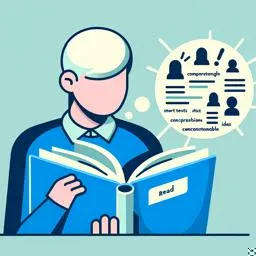Reading and understanding short texts and paragraphs is a fundamental skill in mastering the English language, especially at the A2 level. This skill not only helps in improving language proficiency but also enhances comprehension abilities, which are crucial for both academic and everyday communication. Let's delve deeper into the strategies and benefits of reading and understanding short texts and paragraphs.
One of the primary benefits of focusing on short texts is that they are less intimidating for learners. Unlike long articles or books, short texts provide a manageable chunk of information that can be easily digested. This makes it easier for learners to focus on understanding the content without feeling overwhelmed. Moreover, short texts often contain concise and precise language, which helps learners to quickly grasp the main ideas and themes.
When approaching a short text, it is important to first skim the material to get a general sense of the content. Skimming involves quickly running your eyes over the text to identify key words, phrases, and ideas. This technique helps in building a mental framework of the text, making it easier to understand the details upon a closer read. For instance, if you are reading a short paragraph about a historical event, skimming can help you identify the event, the key figures involved, and the outcome.
Once you have a general understanding of the text, the next step is to read it more thoroughly. This involves reading each sentence carefully and paying attention to the structure and vocabulary used. At this stage, it is beneficial to highlight or underline unfamiliar words or phrases. This not only aids in vocabulary building but also helps in understanding the context in which these words are used. For example, encountering a word like "revolutionary" in a text about technological advancements can provide insights into the impact and significance of the innovations discussed.
Understanding the structure of a paragraph is also crucial in comprehension. A well-structured paragraph typically begins with a topic sentence that introduces the main idea. This is followed by supporting sentences that provide details, examples, or explanations to elaborate on the topic. Finally, a concluding sentence may summarize the main idea or provide a transition to the next paragraph. Recognizing this structure can help learners to better organize the information in their minds and improve recall.
Another effective strategy is to ask questions while reading. This can be as simple as asking who, what, where, when, why, and how. These questions guide the reader to focus on the essential elements of the text and enhance understanding. For example, in a short text about climate change, asking questions like "What are the main causes of climate change?" or "How does climate change affect the environment?" can direct attention to the critical points presented by the author.
Summarizing the text after reading is another useful technique. This involves condensing the main ideas and supporting details into a shorter form, which reinforces understanding and retention. Summarizing encourages active engagement with the text and helps in identifying the most important information. For instance, after reading a text about a scientific discovery, summarizing it in a few sentences can solidify your grasp of the discovery's significance and implications.
Practicing these strategies regularly can significantly enhance reading comprehension skills. It is also beneficial to expose oneself to a variety of short texts, such as news articles, blog posts, short stories, and informational paragraphs. This diversity not only broadens vocabulary but also familiarizes learners with different writing styles and formats.
Moreover, reading short texts can improve critical thinking skills. As learners analyze and interpret the information presented, they develop the ability to evaluate arguments, identify biases, and draw conclusions. This analytical approach is invaluable not only in academic settings but also in everyday decision-making and problem-solving.
In addition to these strategies, utilizing technology can further aid in improving reading comprehension. There are numerous online resources and applications designed to assist learners in enhancing their reading skills. These tools often provide interactive exercises, quizzes, and feedback that make the learning process engaging and effective.
In conclusion, reading and understanding short texts and paragraphs is a vital skill for A2 level English learners. By employing strategies such as skimming, thorough reading, questioning, and summarizing, learners can improve their comprehension abilities and gain confidence in their language skills. Regular practice, exposure to diverse texts, and the use of technology can further enhance this process, making it an enjoyable and rewarding journey towards language mastery.








